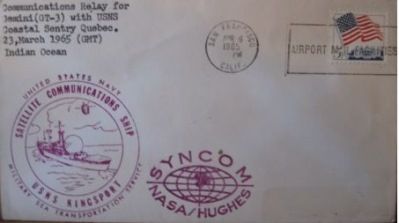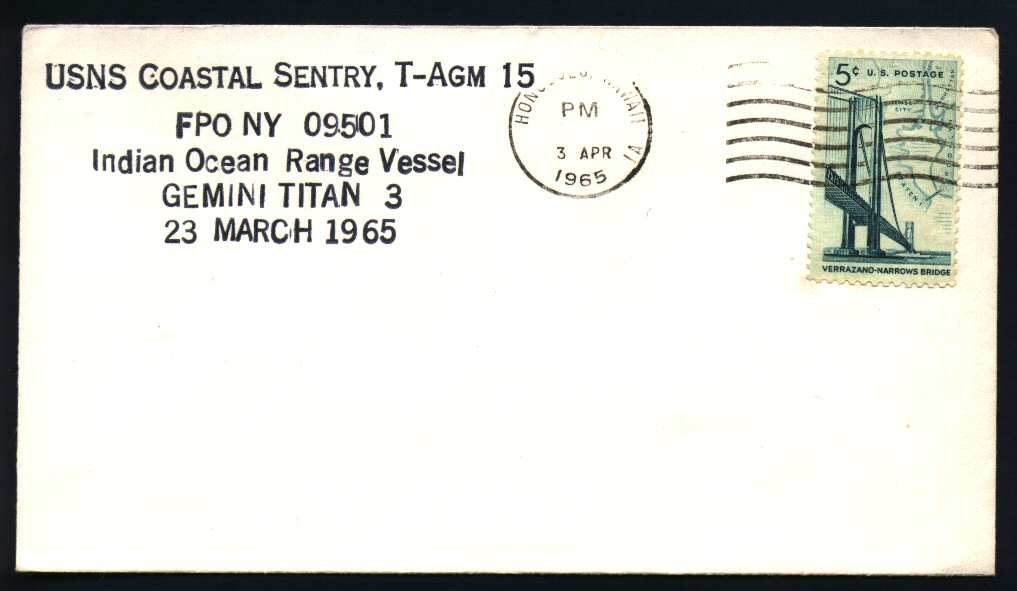Space Cover 347: Gemini 3 Tracking Ships USNS Kingsport and USNS Coastal Sentry QuebecFrom unmanned missions in the 1950s through the early shuttle missions (until the TDRS satellites made them obsolete) tracking ships have played a major role in space flight.
These ships were positioned where land based tracking stations could not and were positioned to provide valuable communication links to the spacecraft during the flights.
During the early 1960's NASA manned spaceflight had begun and communication with the spacecraft was handed off to the network of tracking stations and ships. For each launch, every tracking ship hosted a capsule communicator (CapCom) and at least two flight surgeons to monitor spacecraft systems and to help astronauts with health emergencies.
At least two astronauts served as CapComs aboard tracking ships. The USNS Rose Knot Victor hosted Alan Shepard during Wally Schirra's Mercury 8 flight in October 1962, and for the final Mercury mission, in May 1963, John Glenn manned the USNS Coastal Sentry Quebec's console for Gordon Cooper. Glenn's presence proved crucial when Cooper's electrical systems began to fail. Glenn radioed Cooper with the modified procedures and maneuvers for manual reentry, which resulted in Cooper's flawless return.
The tracking ships again showed their value during an emergency that arose in March 1966 during Gemini 8. Dick Bodette, then the USNS Coastal Sentry Quebec's operations manager, remembers, "There was always a little thrill when we locked onto the astronauts' signal, but this was the 10th mission for some of us, and maybe a bit of the thrill was wearing off. That all changed when we saw the Gemini's wildly fluctuating beacon and realized the oscillations could only be caused by a tumbling spacecraft." Moments later, astronauts Neil Armstrong and Dave Scott confirmed Bodette's fears.
Armstrong stabilized the craft, but Gemini 8's flight plan was suddenly obsolete. The astronauts' lives depended on receiving a new set of deorbit data, and their only chance for receiving it lay with the USNS Rose Knot Victor and the USNS Coastal Sentry Quebec, the only tracking stations in the spacecraft's path. These few minutes of contact proved to be sufficient. Flight controllers invented alternate deorbit plans, and, with the help of a nearby ship that had satellite transmission capability (like the USNS Kingsport), Bodette's crew received this information and relayed it to the Gemini crew.
The cover pictured above is from the USNS Kingsport which was stationed with the USNS Coastal Sentry Quebec for the Gemini 3 mission. During the mission's first orbit, over the ship USNS Coastal Sentry Quebec (designated CSQ) in the Indian Ocean, the ship tracked the mission as the Gemini capsule performed a translational burn of 10 feet per second to change their flight path to be on the correct trajectory to the landing target.
The manned space missions could not have taken place without the support of the tracking stations on land and sea. So while looking for recovery ships in those naval cover boxes if you see a USNS Kingsport, USNS Rose Knot Victor, or USNS Coastal Sentry Quebec cover in the 1960s it may be related to a manned space flight.
Unlike most US Navy ships, the tracking ships did not have a post office on-board the ship so covers were postmarked at locations when they reached port. So for Gemini 3 the USNS Kingsport and USNS Coastal Sentry Quebec was located in the Indian Ocean for the flight but the cover is postmarked in San Francisco in April upon return to port.













